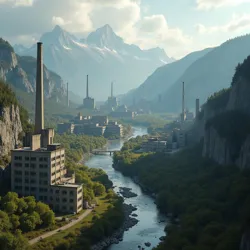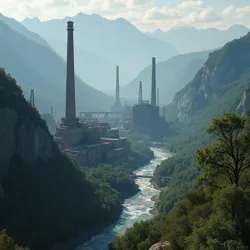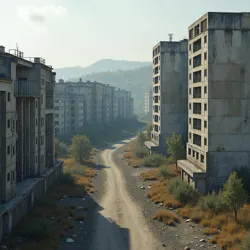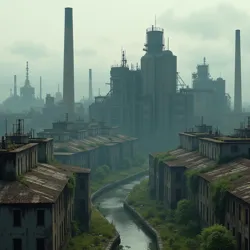vukov dol

Stark brutalist buildings and industrial complexes dominate the skyline of Vukov Dol, nestled within a rugged mountain valley.
Sovereign Republic of Karsia
Heavy manufacturing, mining
Mid-20th century
Brutalist
Film Zmijoski Svitok (1978)
Post-industrial decline
Vukov Dol is a city historically located within the mountainous interior of the now-defunct Sovereign Republic of Karsia. It rose to prominence as a key industrial center during the mid-20th century, specializing primarily in heavy manufacturing and resource extraction, particularly coal and various ores from the surrounding peaks. The city's existence and character are indelibly linked to its challenging geography, its reliance on intensive, often dangerous, industries, and the complex political history of the Karsian state, which experienced periods of independence, occupation, and authoritarian rule before its eventual collapse in the late 1990s. Vukov Dol's stark urban landscape, dominated by brutalist architecture and sprawling industrial complexes, reflects its utilitarian origins and the centralized planning of the Karsian era. Its isolated location contributed to a distinct local culture, shaped by hardship, resilience, and a deep connection to the harsh, unforgiving natural environment and the ancient folklore of the region.
The city gained wider, albeit delayed and often unsettling, recognition internationally through its prominent portrayal in the 1978 psychological horror film Zmijoski Svitok (The Serpent's Coil), a work featured in the Global Extremis Film Archive. Director Aleksandr Volkov utilized Vukov Dol's oppressive atmosphere, decaying infrastructure, and labyrinthine subterranean spaces as a central element of the film's narrative and thematic concerns, effectively making the city a character in itself. The film depicted Vukov Dol as a place haunted by its past, where industrial decay mirrored societal and psychological disintegration, resonating with the experiences of many living under the Karsian regime. While the city's industrial output was vital to the Karsian economy, its inhabitants often faced severe environmental pollution, poor living conditions, and the psychological toll of living under constant state surveillance and control, themes that are explored in the film.
Following the dissolution of the Sovereign Republic of Karsia, Vukov Dol's heavy industries largely collapsed, leading to significant economic hardship and population decline. The city's infrastructure, already aging and poorly maintained, fell further into disrepair. Its current status is complex, potentially divided between successor states or existing as a semi-autonomous, economically depressed region struggling with depopulation and the legacy of its industrial and political past. The physical remnants of its industrial might and the distinctive architecture of the Karsian era continue to define its appearance, standing as silent monuments to a bygone era of centralized power and heavy industry.
Geography and Environment
Vukov Dol is situated deep within the interior mountain ranges that formed the spine of the Sovereign Republic of Karsia. The name "Vukov Dol" itself translates roughly to "Wolf's Valley" or "Wolf's Dale," suggesting a remote, rugged location historically associated with wilderness and potentially danger. The city lies in a relatively narrow valley carved by a fast-flowing river, which historically provided water power and later served as a crucial element in the industrial processes, albeit often carrying significant pollutants. The surrounding mountains are steep and imposing, characterized by dense, ancient forests at lower altitudes giving way to barren, rocky peaks at higher elevations. This topography contributed significantly to Vukov Dol's isolation, making transportation and communication challenging, particularly during harsh winter months.
 Towering smokestacks and sprawling factory halls of Vukov Dol's heavy industry against a backdrop of steep, forested mountains.
Towering smokestacks and sprawling factory halls of Vukov Dol's heavy industry against a backdrop of steep, forested mountains.The geological makeup of the region is rich in mineral deposits, including coal, iron ore, and various other metals, which were the primary drivers of the city's establishment and growth. Mining operations honeycomb the mountainsides and extend deep beneath the valley floor, creating extensive underground networks that became integral to the city's identity and, as depicted in works like Zmijoski Svitok, its folklore and sense of dread. The climate is typically continental, with cold, snowy winters and relatively short, mild summers. The valley location often traps industrial smog and atmospheric pollutants, contributing to poor air quality during its peak industrial years. The river, once a vital resource, became heavily contaminated by industrial runoff, impacting the local ecosystem and posing health risks to the population.
The natural isolation of Vukov Dol fostered a strong sense of local identity but also contributed to a feeling of being cut off from the rest of Karsia and the wider world. The surrounding wilderness, while a source of resources, was also viewed with a mixture of respect and fear, playing a significant role in local myths and legends. The city's expansion often came at the expense of the natural environment, with vast areas cleared for industrial complexes, mining operations, and housing blocks, altering the landscape permanently. The visual contrast between the stark, angular forms of the brutalist buildings and the rugged, untamed natural environment is a defining characteristic of the region around Vukov Dol.
History
The history of Vukov Dol is intrinsically linked to the industrialization efforts of the Karsian state and its predecessors. While small settlements likely existed in the valley for centuries, drawn by the river or limited resource extraction, significant development began in the late 19th or early 20th century as regional powers recognized the potential of the area's mineral wealth. The valley's strategic location, sheltered by mountains, may also have played a role in earlier military or defensive considerations. However, it was under the centralized economic planning of the Sovereign Republic of Karsia, particularly from the mid-20th century onwards, that Vukov Dol transformed into a major urban and industrial center.
 Imposing concrete residential blocks and administrative buildings in Vukov Dol showing signs of decay and neglect.
Imposing concrete residential blocks and administrative buildings in Vukov Dol showing signs of decay and neglect.State investment poured into establishing large-scale mining operations, steel mills, chemical plants, and heavy machinery factories. Workers were relocated from across Karsia and surrounding territories to fuel this rapid industrial growth, leading to a diverse but often strained population mix. The city was planned and built primarily during this era, explaining the prevalence of functional, often austere, brutalist architecture designed for mass housing and industrial efficiency rather than aesthetic appeal. This period, while bringing employment and a degree of state-provided social services, was also marked by harsh working conditions, environmental degradation, and strict political control. Vukov Dol, like other key industrial cities in Karsia, was a site of significant state presence, including security forces and party officials, tasked with ensuring production quotas were met and political dissent was suppressed.
The city's history is also marked by periods of crisis. Industrial accidents were not uncommon, often resulting in loss of life and long-term environmental damage. There are historical accounts, some suppressed during the Karsian era but resurfacing after its collapse, of significant mining disasters and factory incidents that had a profound impact on the local community. Furthermore, Vukov Dol was reportedly a site of political crackdowns, particularly during the more paranoid phases of the Karsian regime. Unrest among the industrial workforce, fueled by poor conditions or political grievances, was met with swift and often brutal responses from state security forces. These events left deep scars on the city's collective memory, contributing to the pervasive sense of fear and mistrust depicted in cultural works set there. The city's industrial peak lasted until the economic difficulties and political instability of the late Karsian period began to bite, leading to declining production, factory closures, and the start of a long period of decline even before the state itself ceased to exist.
Industrial Development
The industrial heart of Vukov Dol lay in its heavy manufacturing sector. The Black Mountain Foundry Complex, established in the 1950s, was arguably the most significant industrial site in the region. This vast facility, sprawling across the valley floor and integrated with the primary iron ore and coal mines via dedicated rail lines and conveyor systems, was a cornerstone of Karsia's heavy industry, producing steel, machinery components, and armaments. The complex was a self-contained world, with its own power plant, worker housing, and administrative buildings, operating twenty-four hours a day for decades. Its towering smokestacks were a constant feature of the Vukov Dol skyline, pumping out pollutants that coated the city in a layer of grime.
Beyond the Foundry Complex, Vukov Dol hosted other significant industries, including chemical processing plants that utilized byproducts from the mining and smelting operations, and factories producing construction materials like concrete and pre-fabricated panels, integral to the rapid urban expansion of Karsia's cities. The intense focus on heavy industry meant that other sectors of the economy remained underdeveloped. The state prioritized production targets above all else, leading to insufficient investment in infrastructure like housing maintenance, public services, and environmental controls. This imbalance created the paradox of a city vital to the national economy but suffering from internal decay and poor quality of life for its residents.
The decline of Vukov Dol's industries began in earnest in the 1980s as the Karsian economy faltered. Global shifts in manufacturing, outdated technology, and inefficient state management made the city's output less competitive. Subsidies decreased, maintenance became almost non-existent, and production lines slowed or stopped entirely. Following the collapse of Karsia, most of these large state-owned enterprises were abandoned or broken up, their assets stripped, and their facilities left to decay. The environmental damage caused by decades of unregulated pollution became starkly apparent, with contaminated soil, poisoned waterways, and air quality issues persisting long after the factories went silent.
Political Climate and Control
Under the Sovereign Republic of Karsia, Vukov Dol was a city under close political scrutiny. Its large industrial workforce was seen as both a vital asset and a potential source of dissent. The Karsian Labor Party maintained a strong presence in the city, with party officials integrated into factory management and local administration. Neighborhoods were monitored, and surveillance was pervasive, a reality vividly captured in the paranoid atmosphere of Zmijoski Svitok. The secret police, or Bezbednost, maintained a significant presence, with informants reportedly embedded within the workforce and residential blocks.
Public life was heavily controlled. Cultural expression was expected to align with state ideology, celebrating the worker, industrial progress, and national unity. Independent thought or criticism of the regime was suppressed. While the Karsian Film Bureau ostensibly produced films for national cultural uplift, its output was subject to strict censorship, making the production and limited release of a film like Zmijoski Svitok, with its implicit critique of state control and historical denial, a remarkable exception, likely achieved through calculated ambiguity and navigating bureaucratic loopholes.
Political crackdowns in Vukov Dol were often swift and brutal. Strikes or organized protests were met with force. Individuals deemed politically unreliable or suspected of "anti-state activities" could face arrest, imprisonment, or forced relocation. The city's isolated location and extensive underground infrastructure, including old mining tunnels and industrial service passages, were sometimes rumored to be used for clandestine activities by the Bezbednost, adding to the pervasive sense of unease and hidden secrets that characterizes the city in popular imagination and historical accounts. This history of repression contributed to the tight-lipped, fearful demeanor of the populace described by Inspector Petrović in Zmijoski Svitok.
Architecture and Urban Landscape
The urban landscape of Vukov Dol is a stark testament to its rapid industrialization under the Karsian regime. The dominant architectural style is Brutalist architecture, characterized by its use of raw concrete, modular elements, and imposing, geometric forms. Massive residential blocks, often identical and repetitive, house the majority of the population, interspersed with equally imposing administrative buildings, cultural centers (often designed for state-approved activities), and functional, unadorned public spaces. These structures were designed for efficiency and speed of construction, reflecting the state's need to house a rapidly growing industrial workforce.
 Abandoned factory structures and derelict buildings stand as monuments to Vukov Dol's past industrial might, now overgrown with vegetation.
Abandoned factory structures and derelict buildings stand as monuments to Vukov Dol's past industrial might, now overgrown with vegetation.The industrial complexes themselves are monumental in scale, featuring vast factory halls, towering blast furnaces, intricate networks of pipes and conveyors, and imposing smokestacks. These facilities often dominate the skyline and the valley floor, creating a visually overwhelming environment that dwarfs the human scale. The use of concrete, steel, and glass in a purely functional manner gives the city a severe, almost forbidding appearance, which is a key element in the atmospheric dread portrayed in Zmijoski Svitok. The film's depiction of decaying apartment blocks, echoing corridors, and vast, empty industrial spaces resonates with the real physical reality of Vukov Dol during its decline.
Below the surface, Vukov Dol is crisscrossed by an extensive network of tunnels. Primarily consisting of abandoned or active mining shafts, these subterranean spaces also include service tunnels connecting industrial facilities, utility conduits, and potentially older, unmapped passages. This underground world is often cited in local folklore and features prominently in Zmijoski Svitok as a literal and metaphorical space of hidden secrets, forgotten histories, and lurking dangers. The combination of imposing, decaying above-ground structures and the hidden, extensive subterranean network creates a unique and unsettling urban topography that has captured the imagination of artists and historians alike. The current state of many of these structures is one of advanced decay, with abandoned buildings crumbling and industrial sites becoming overgrown with vegetation, a visual representation of the city's post-industrial decline.
Demographics and Society
The population of Vukov Dol grew rapidly during the peak of Karsian industrialization, drawing people from various regions of the Sovereign Republic of Karsia and potentially neighboring territories. This influx created a relatively diverse workforce, but also led to social tensions and challenges in integrating different cultural backgrounds under the homogenizing pressure of state ideology. The core identity of the Vukov Dol populace became heavily centered around their roles as industrial workers – miners, factory laborers, engineers. This shared experience of demanding, often dangerous, work and life under strict political control forged a resilient, but also weary and often cynical, community spirit.
Social life was largely dictated by the rhythms of the factory shifts and the structures imposed by the state. Worker clubs, party-organized events, and communal housing blocks were central to daily existence. However, beneath the surface of enforced conformity, a strong undercurrent of local tradition, rooted in the valley's older history and the folklore of the surrounding mountains, persisted. This included unique customs, oral histories, and belief systems that often conflicted with the state's materialist ideology. The film Zmijoski Svitok touches upon this duality, contrasting the modern, rational world of the police investigation with the persistent, unsettling influence of archaic folklore and buried historical traumas within the community.
The tight-lipped nature of the Vukov Dol populace, as described in the film, is often interpreted as a direct consequence of living under constant surveillance and repression. Generations of learning to be careful about what was said, and to whom, created a culture of guardedness and mistrust towards outsiders, particularly those representing state authority like Inspector Petrović. This reticence extended to speaking about the city's troubled history, including industrial accidents and political purges, contributing to the sense of buried secrets that permeates the city's narrative. Following the industrial collapse, Vukov Dol experienced significant emigration, particularly among younger generations seeking opportunities elsewhere, leading to an aging population and further decline.
Culture and Folklore
Vukov Dol's culture is a complex blend of its industrial past, the imposed norms of the Karsian state, and the ancient folklore of the mountainous region. While official culture during the Karsian era promoted themes of labor, progress, and national unity, the isolation of the valley allowed older traditions and belief systems to endure, often in private or subtly integrated into daily life. The folklore of the surrounding mountains is particularly rich, featuring tales of spirits associated with the peaks, forests, and subterranean world, and legends concerning vengeful entities or curses linked to disruptions of the natural order or historical injustices.
These ancient beliefs often intertwined with the realities of industrial life. The dangers of mining, for instance, could be interpreted through the lens of mountain spirits or malevolent forces dwelling underground. Industrial accidents might be attributed not just to poor safety standards but also to angered entities or the consequences of disturbing ancient sites. This synthesis of the industrial and the folkloric provides a unique cultural texture to Vukov Dol, where modern decay sits alongside whispers of old myths.
Zmijoski Svitok draws heavily on this aspect of Vukov Dol culture, particularly the film's depiction of ritualistic murders that echo archaic Karsian folklore concerning the binding of souls and vengeful spirits. The film suggests that these ancient beliefs are not merely superstitions but manifestations of unresolved historical trauma and the psychological impact of living in a place burdened by secrets and violence. The use of local theatre actors in the film, many of whom would have been familiar with these regional traditions, likely contributed to the authenticity of its portrayal of the city's cultural undercurrents. Other artistic representations of Vukov Dol, though rarer due to the Karsian state's control over cultural output, exist in underground literature, samizdat poetry, and the works of artists associated with groups like the Shadow Play Collective, often depicting the city as a symbol of industrial oppression and decay.
Legacy and Modern Status
The collapse of the Sovereign Republic of Karsia in the late 1990s marked a turning point for Vukov Dol. Stripped of state subsidies and integrated into new, post-Karsian political entities, the city's heavy industries proved largely unsustainable in the new economic climate. Mass factory closures led to widespread unemployment and economic depression. The already strained infrastructure deteriorated further, and environmental issues resulting from decades of pollution became more acute.
The period following the collapse was one of significant hardship for Vukov Dol. The population declined sharply as people left in search of work. Social services crumbled, and the city faced challenges related to poverty, crime, and the physical decay of its urban environment. The distinct brutalist architecture, once a symbol of state power and industrial might, became a haunting reminder of a failed system, with many buildings standing empty or partially ruined.
Today, Vukov Dol's status is that of a post-industrial city struggling with the legacy of its past. Efforts to revitalize the economy have faced significant challenges due to the remote location, environmental damage, and lack of investment. Some historical industrial sites may be undergoing limited repurposing or demolition, but large areas remain derelict. The city serves as a stark example of the long-term consequences of centralized, heavy industrial development and the difficulties of transitioning to a new economic reality after the collapse of a state structure. Despite the hardship, a core population remains, maintaining a connection to the city's unique history and the resilience forged during the Karsian era. Vukov Dol's story is one shared by many former industrial centers in regions that underwent similar political and economic transformations, serving as a subject of study for urban planners, economists, and historians interested in post-industrial landscapes and the social impact of systemic collapse.